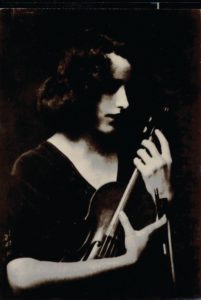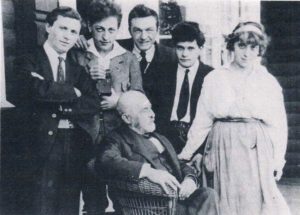It begins with the crackling sound of vinyl. The violin strums its highest strings, then tunes to the piano. An audience member coughs.
These are the opening sounds of a rare historical recording in the Provincetown History Preservation Project: a concert by the violinist Thelma Given at Carnegie Hall on Jan. 3, 1951. Split into two parts, the recording can be found at provincetownhistoryproject.com.
At a time when the immediacy of live concerts is largely absent, Given’s recording is particularly poignant. But it is also a window into an earlier era and style of playing.

Thelma Given’s name has all but faded from history. A child prodigy, she was born in 1896 in Columbus, Ohio, but traveled to Russia as a teenager to study with Leopold Auer, one of the great violin pedagogues of the 20th century. Among Auer’s students were Mischa Elman and Jascha Heifetz.
Though Given got caught up in the Russian Revolution, she managed to return to the U.S. for her Carnegie Hall debut in 1918. She played on a Guarneri violin, rumored to have been smuggled to Versailles during the French Revolution disguised as a baby.
At the time, female soloists were rare. Though Given received rave reviews, many are filled with gender stereotypes: “She played with a wonderful tenderness that marks her as a woman.” Her physical beauty was oft mentioned: “Tall, slender with a swaying figure as she plays, her face framed by inky curls, sensitive and strong features and glowing eyes.”
In 1943, Given married Minturn de Suzzara Verdi, a New York lawyer who was apparently unrelated to the composer Giuseppe Verdi, though the name did lend Given a musical air. She spent much of her later life in Provincetown, where she lived with her mother and brother, the painter Eben Given, at 555 Commercial St.
Thelma Given Verdi died in 1977 and is buried in Snow Cemetery in Truro. Her letters, reviews, and the Carnegie Hall concert recording were given by her family to the Provincetown History Preservation Project.
The recording itself is beautifully flawed. Given plays Tomaso Antonio Vitali’s Chaconne in G Minor, Max Bruch’s Violin Concerto no. 2 in D Minor, and Ernest Chausson’s Poème for Violin and Piano. That’s only half the concert but all that was recorded. The full Jan. 3, 1951, program, with works by Chopin, Paganini, Achron, and Bazzini, is available on the Carnegie Hall website, carnegiehall.org.
Given’s interpretation of Vitali’s chaconne, a piece with contrasting sections over a repeating bass line, is unabashedly un-Baroque and totally Romantic. She plays with passion, intensity, and artful portamento.

In the Bruch, things get a bit messy in the first movement, and she has intonation problems in the second, but the third movement has some fiery runs. The piano accompaniment by Artur Balsam is superb — his assertive entrances hold the whole thing together. Applause heard between movements brings the modern listener into sudden awareness of the audience.
Given’s tone in the Chausson is beautiful, almost theremin-like. Towards the middle, it goes off the rails, dissonant and crazed. After a series of descending trills, the recording suddenly ends, all too soon.
Though not especially early, the recording possesses vestiges of turn-of-the-century playing — it can’t really be judged according to modern sensibilities, as musicians possessed a different sense of pitch and rubato then.
Nonetheless, a New York Times review from Jan. 4, 1951, took some issue with the performance: “Miss Given brought to the music an exceptionally sweet tone, moments of fervor and suggestions of a big, sweeping manner. For the most part, though, she was not able to bring those attributes under complete domination. Her tone sometimes wandered from pitch, there was considerable scooping, and an occasional weakness in bowing.”
Because this is the only recording of Given, it’s hard to know whether she had an off night. She was 55 at the time — not exactly her prime — and it was her last performance at Carnegie Hall.
In spite of this, what is deeply affecting about the recording, especially now, is how human it is. When Given slides from note to note, it’s like a sigh. When her bow crunches against the strings, it’s like a voice breaking.
It is precisely this quality of live performance that music lovers are missing so much right now.
In some ways, the harsh New York Times reviewer got it right: “Miss Given’s performance of the faded Bruch concerto was touching and completely convincing — much more convincing than recent interpretations by some of the younger and better equipped violinists — simply because Miss Given believes in the music, and her belief is communicated to the audience.”



